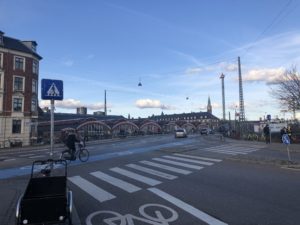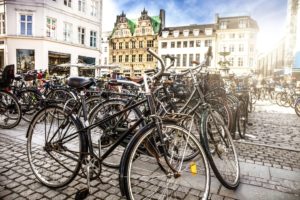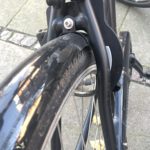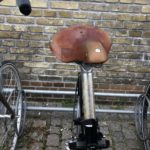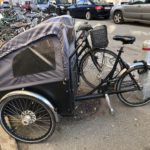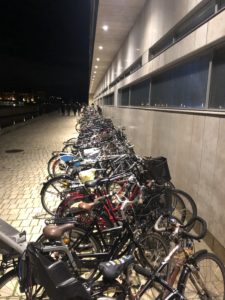Cycling in Copenhagen
|
Copenhagen has a well-deserved reputation for being a bike-friendly city. I spent a week there recently, riding over fifty miles (80 kilometers) in the city over the course of several days. (Here’s a typical ride) Here’s what I noticed.
Every day is like Sunday
Having fewer cars on the roads creates a lot of advantages. The sight lines are better. The traffic lights are timed for walkers and cyclists without having to accommodate a lot of motorists flowing through. In five hours of city riding I had exactly zero unnerving experiences in traffic. I never felt threatened, hurried or confused. The general vibe among pedestians, bikes, and cars is very relaxed. When in doubt, people take turns or slow. The stress level is low. There’s one speed and it’s 15 kph And the bikes are crap. So what?
The riding position is very upright. I don’t particularly like the low-speed handling of these bikes, which seems like an important characteristic for city riding. The front wheel has very little weight on it, it’s hard to lift the front wheel over obstructions because your hands are positioned really far back, and there’s not much wheel flop. The bottom brackets seem needlessly high, so it’s hard to put a toe down at a stop and remain seated. The rear coaster brake is a pain because you can’t backpedal into a good pedal position for starting. That makes starting up again into an awkward little shuffle. If I lived in Copenhagen I’d make a few bike choices that would create a better city bike for me, but most Danes don’t seem to bother. The bikes are so nondescript and the crime rate is so low that virtually all of these bikes are locked with a simple rear wheel cuff that prevents the wheel from turning.
It’s very liberating to not worry about your bike being stolen. My hotel’s free loaner bike had a $125 Brooks leather saddle that was attached only by a quick release lever and looked like it had been in place for quite some time. In New York or San Francisco this saddle would be stolen in seconds.
Danes use cargo bikes, and it’s interesting that they seem to prefer Danish Christiana-style three-wheeled cargo bikes over Dutch-style two-wheeled Bakefiets bikes. I wonder what the pros and cons of these two styles of cargo bikes are.
Lights? Not so much
Danes use hand signals – not always, but reasonably frequently, and a lot more often that most cyclists do elsewhere. The left hand held up means “Stop”, which is interesting because it looks to me more like a left hand turn. I’m used to holding my hand down to signal a stop. One aspect of Copenhagen cycling that doesn’t work so smoothly, especially for an outsider, is the procedure for making left hand turns. To go left, cyclists keep to the right and cross straight. They then stop, reposition the bike pointing left, and wait of the light to change again before proceeding straight again. This creates a strange little mini-pack of cyclists clumsily repositioning their bikes (which are heavy and maneuver poorly at low speed) in front of the already-waiting cyclists going straight at any intersection. But they all honestly do this, instead of just cutting left. There’s even a section about this in the safety video at bike-rental shops. This would be a lot worse if the lights were timed to favor cars, but the traffic light sequences in Copenhagen were one of the biggest surprises for me – there’s a separate light for bikes and the light for cars isn’t that long, so it doesn’t take that much longer to wait for the light to change again in a two-stage left turn. Where do cyclists train? It’s fun – if you’re in Copenhagen, try biking |

